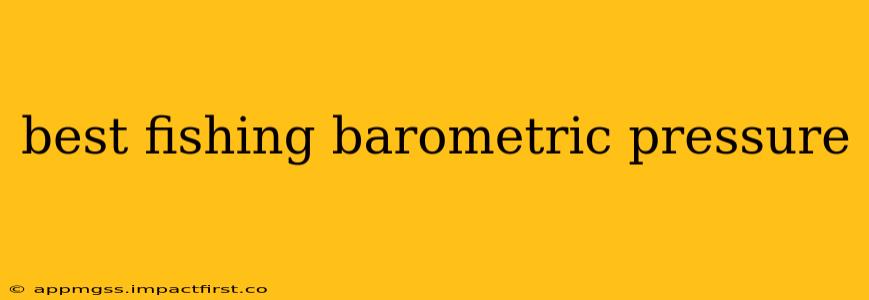For anglers, the quest for the perfect fishing day often involves more than just the right bait and location. Understanding the relationship between barometric pressure and fish behavior can significantly increase your chances of a successful outing. While there's no single "best" barometric pressure for fishing, certain pressure ranges generally correlate with increased fish activity. This article will delve into the intricacies of this relationship, answering common questions anglers have about barometric pressure and fishing success.
What is Barometric Pressure, and Why Does it Affect Fishing?
Barometric pressure refers to the weight of the atmosphere pressing down on the Earth's surface. It's measured in millibars (mb) or inches of mercury (inHg). Changes in barometric pressure affect the amount of dissolved oxygen in the water. Fish, like all living creatures, require oxygen to survive. When barometric pressure changes rapidly or drops significantly, the dissolved oxygen levels in the water can decrease, potentially impacting fish activity and feeding patterns.
What is the Best Barometric Pressure for Fishing?
Many anglers find that stable barometric pressure between 29.80 and 30.20 inches of mercury (or 1008-1020 millibars) is ideal for fishing. During these stable conditions, fish are generally more active and willing to feed. However, this isn't a hard and fast rule. Other factors, such as water temperature, time of day, and the species of fish being targeted, also play crucial roles.
What Barometric Pressure Makes Fish Bite More?
While stable pressure in the "ideal" range is often good, fish can also bite aggressively during periods of slowly falling barometric pressure. This slow drop often precedes a weather system and can stimulate feeding activity before conditions worsen. Conversely, rapidly falling or rising barometric pressure frequently results in decreased fish activity.
Does High Barometric Pressure Affect Fishing?
High barometric pressure, while sometimes leading to stable conditions beneficial for fishing, can also suppress fish activity, particularly if it’s very high or changes rapidly. Fish may become less active and feed less frequently under these conditions.
Does Low Barometric Pressure Affect Fishing?
Low barometric pressure can also negatively impact fishing, especially if it's coupled with rapid changes. The reduced oxygen levels in the water can make fish lethargic and less inclined to feed. However, a slow fall, as mentioned above, can sometimes trigger feeding frenzies.
How to Check Barometric Pressure for Fishing?
Many weather apps and websites provide real-time barometric pressure readings. Some dedicated fishing apps even incorporate barometric pressure data alongside other crucial fishing information. A barometric pressure gauge can also be a valuable tool for anglers who want to monitor conditions closely.
What Other Factors Influence Fishing Besides Barometric Pressure?
While barometric pressure is a significant factor, it's not the only one. Other influential elements include:
- Water Temperature: Fish are cold-blooded and their metabolism is directly affected by water temperature.
- Time of Day: Fish often exhibit specific feeding patterns throughout the day.
- Moon Phase: Some anglers believe that the moon phase affects fish behavior, though scientific evidence is inconclusive.
- Season: Different fish species are active during various times of the year.
- Water Clarity: Clear water allows fish to see potential threats and may make them less likely to bite.
- Current and Water Level: These factors influence the distribution of baitfish and the accessibility of fish to fishing locations.
By considering all these variables along with barometric pressure, you can significantly improve your fishing success rate. Remember that consistent monitoring and observation are key to understanding the best conditions for your preferred species in your specific fishing location.
